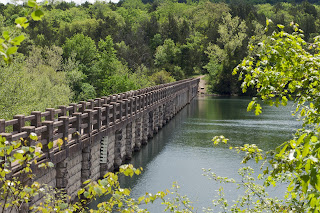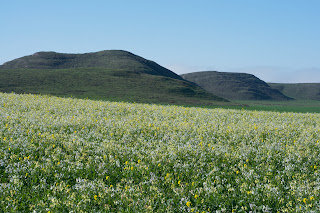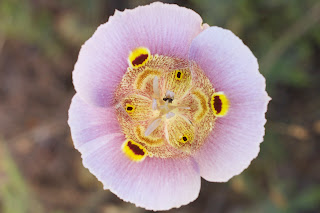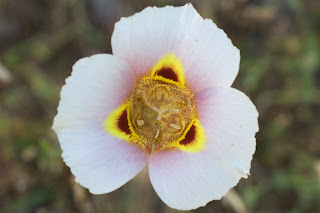 |
| Lake Leatherwood Dam, Eureka Springs |
Lake Leatherwood is a spring fed montane lake in the Ozarks of northwestern Arkansas. It's right outside the 19th century 'healing waters' health resort of
Eureka Springs. The entire area is still relatively wild, with several national forests and state parks within easy driving distance.
The lake and dam were part of the Works Progress Association stimulus efforts to get people working during and immediately after the Great Depression of the early 20th century. The lake is surrounded by a beautiful second growth forest with pockets of
cedar glades and still retains a fairly diverse flora.
 |
| Mixed Broadleaf Forest |
This region of Arkansas is the western edge of the
Southeastern coniferous and broadleaf forest ecoregion, an ecoregion with almost 200 tree species, over 35 of which are endemic. This particular ecoregion has more than
3500 species of herbs and shrubs, the highest species count of any
bioregion in North America.
 |
| Glandularia canadensis |
Brian and I took a 3-4 hour walk around the perimeter trail surrounding
the lake. I was optimistic we would see some nice flowers and wasn't disappointed. We parked at an open clearing with picnic tables and a view of the lake water through some trees and then headed towards the start of the trail, which resembled what we call in California a fire road. We saw lots of
Glandularia canadensis, a lovely spring flower in the Verbenaceae, growing in a large clump at the start of the trail. A good sign!
Once on the trail the dominant floral feature was incredible diversity of trees and shrubs. The trees had just finished leafing out and many were still a pale,
bright green, in contrast to the darker rich green they attain after
full leaf out. Looking up over our heads we found mid-sized shrubs and small trees glowing green in the dappled morning light, with species such as
Celtis laevigata, Quercus muehlenbergii, and
Cornus florida providing rich textures.
 |
| Lithospermum canescens |
Wandering up a short spur trail higher along the ridge we found our first cedar glades where ferns,
Lithospermum canescens and
Hypoxis hirsuta were abundant. The
Hypoxis in particular seemed to be an indicator species for the presence of a glade. Additional flowering herbs along this side trail included
Enemion biternatum, Phlox divaricata, Oxalis violacea, and
Cynoglossum virginianum. Two of the more impressive flowering shrubs were
Viburnum rufidulum and
Vaccinium stamineum.
 |
| Camassia scilloides |
I was excited to encounter my first geophyte,
Camassia scilloides. This spring bulb has pale blue flowers with bright yellow stamens. As we continued walking we saw
Ranunculus recurvatus, Senecio aureus, Aesculus glabra, and our second geophyte,
Trillium viridescens.
We'd reached the approximately halfway point by this time. The trail so far was too far inland from the lake shore for us to really see the lake but now we had to cross the dam to reach the other side. Good things come to those who wait! We were literally speechless at the sight of the dam and then the lake itself as we crossed. The lake is surrounded on both sides by gentle rolling hills, carpeted in dozens of shades of green with a heavy popcorn cloud cover overhead. The area has had a wet winter and spring so the spillway to the dam was in full operation, adding another beautiful component to the walk.
 |
| Lake Leatherwood Dam |
 |
| Delphinium tricorne |
Once we reached the opposite shore we quickly found ourselves walking through an old limestone quarry. Our guide book told us this was the quarry where the WPA quarried the limestone facing blocks for the dam! The resulting return to nature more closely resembled a cedar glade than a forest.
Juniperus virginiana were growing in stunted forms from the cracks in the granite and there were large patches of
Minuartia patula here and there. But what we enjoyed most about the quarry were the thousands and thousands of tadpoles! I'd never seen so many tadpoles in one place. That really spoke to the high quality of the local ecosystem.
 |
| Tadpoles! |
As we continued hiking we crossed several more tranquil cedar glades. We were also much closer to the shore and enjoyed the varying views as the lake came into view from time to time.
Towards the three quarters mark we hit Leatherwood Creek, which feeds into the lake, and the plant communities changed dramatically. We encountered large populations of
Podophyllum peltatum, Pedicularis canadensis, Polemonium reptans, Asarum canadense, Tradescantia species
, Trillium viridescens, and my favorite flower from the whole day,
Delphinium tricorne.
More flowers and scenery from the hike:
 |
| Brian walking in the forest |
 |
| Podophyllum peltatum |
 |
| Lake Leatherwood Dam spillway |
 |
| Hypoxis hirsuta |
 |
| Viburnum rufidulum |
 |
| Asarum canadense |






























































